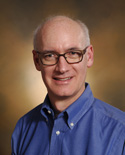

Interview with Dave Piston

IDEX Health & Science: Tell us a little about your academic career and how you ended up at Vanderbilt.
Dave Piston: After receiving my Ph.D. degree in Physics, I wanted to obtain a post-doc position where I could learn about modern digital microscopy. I was fortunate to obtain a post-doc with Watt Webb’s lab at Cornell. Shortly after I arrived there, the two-photon (2P) microscope was invented, and with my background in ultrafast laser Physics, it was a good match for me to work on the further develop of this technique.
At Cornell, there were a lot of biologists were coming up to use our 2P system, so I got a great exposure to a lot of interesting problems/questions in biology.
When I began looking for a tenure-track job, Physics departments were not hiring biophysicists. I had gone on some Physics department job interviews and it became clear that those departments were not seriously looking to grow Biophysics in their departments. That same year, I met some people from Vanderbilt at the Biophysical Society annual meeting. They asked if I had thought about going to work at a medical center because those institutions were all looking to grow their core facilities, especially in imaging. I replied that I had not. Vanderbilt called me a week later and asked if I would come down to give a seminar….I did and a month later I had a job offer.
Vanderbilt was immediately a good fit for me: they wanted someone to start up an imaging core and also offered sufficient start up funding that would allow me to expand my development of two-photon microscopy and take it to the next level. It was nice to have the physics and engineering departments on the same campus, and this allowed me to keep in contact with those fields while expanding my knowledge of biology and explore interesting biological research areas using microscopy and ultrafast lasers.
IDEX Health & Science: How does the future look for biophysics and people wanting to get into this field?
Dave Piston: It is one of the main areas in Biology that is growing. Quantitative measurement and analysis techniques are especially in demand. Today, anyone with rigorous training in these areas is scooped up. Biophysics is not one thing, it is a ‘little bit of everything’ and departments that are hiring recognize this and appreciate the well-rounded scientific thought process biophysicists employ. It is also interesting to note that undergraduate teaching institutions are now also looking to fill faculty positions with Biophysicists.
IDEX Health & Science: You have been a member of the Biophysical Society since 1986. How is the Society?
Dave Piston: Attendance for the Biophysical Society annual meeting keeps growing and has seen no real drop off in attendance year over year. The Society now has over 9,000 members. I have been involved in the leadership of the Society since 2003 and I am currently chairing the Nominating Committee. After this year, I hope to step away from this aspect of the Society, but I have just rejoined the editorial board of the Biophysical Journal.
IDEX Health & Science: What are your predictions for the future regarding ultrafast lasers?
Dave Piston: The cost has got to come down in the near future. Since I began using ultrafast lasers, performance has been continually increasing but the price has remained high (over $180,000). They have pretty much reached the limit of getting better, so I hope that we will soon be reaching the point of a specification driven price decrease, making ultrafast lasers more accessible. Looking at non-ultrafast laser technology, the compact, modular and robust design of currently available solid state lasers needs to come to the ultrafast world. With lower cost and modularity, we could realize simultaneous (or at least very fast) multiple wavelength, multiphoton excitation applications. This development would also allow multi-photon microscopy techniques such as STED, fluorescence lifetime, and spectral imaging to enter the ultrafast space and bring the benefits of localized excitation, reduced photobleaching and improved instrument sensitivity to those techniques.
I think we are also going to see faster tuning (microseconds) over a broader wavelength range for ultrafast lasers where they perform like a CW (continuous wattage) multi-color laser system. We would like to tune from 600nm to above 1200nm…especially into the 1300nm range very quickly so we can improve our understanding of how deep red fluorophores behave under 2P excitation. The 2P spectrum above 1100nm is currently not well understood.
Science keeps increasing its demands on ultrafast laser solutions, so the future should be interesting.
IDEX Health & Science: Tells us a bit about your research.
Dave Piston: We do a lot of collaborations and frequently apply our quantitative expertise to new biological systems. If someone wants to measure something really well, such as looking at just a few fluorescent molecules, they often show up at our door.
Pancreatic islets and insulin secretion from beta cells has been the main area of focus in my lab. Recently, we have begun to look at glucagon secretion from the islet alpha cells. Glucagon is a hormone that gives the opposite effect of insulin: when gluocose levels are low, glucagon secretion increases to signal the liver to produce glucose from stored glycogen. Glucagon and insulin hormones work together antagonistically to keep blood glucose levels stable.
The beta cells that secret insulin and the alpha cells that secret glucagon are very similar in their phenotypes, even though they are counter-regulatory. The inverse response between beta and alpha cells is still very poorly understood even though it has been studied since the 1960’s.
It is always good to find a biological problem that is tractable with the tools you have available. When I started at Vanderbilt, lots of my neighbors were looking at pancreatic islets which seemed a good fit for us because metabolic changes with glucose, Ca transients, and secretion….are important to our understanding and I had the ability to measure these parameters well. It took us 2-3 years to get the first paper out on islets and then the science just flowed from there.
IDEX Health & Science: Your lab also has an interesting history regarding fluorescent proteins.
Dave Piston: If you like to measure things, then fluorescent proteins (FPs) are good. As soon as FPs were introduced in 1994, we jumped over all it and got really deep into the phytophysics. This took a while, and I was sure that everyone else would be characterizing these parameters but in 1995, when we published our first paper, everyone was very interested in our results and contacting us for more details. Marty Chalfie (2008 Nobel Laureate for the discovery and utilization of Green Fluorescent Protein) was organizing a FP meeting at that time and asked me to speak there because ours was one of the first peer reviewed papers on GFP.
George H. Patterson was a Ph.D. candidate in my lab when he discovered that FPs photoswhitched (which was not so useful at the time)…he then went on to a post-doc with Jennifer Lippincott-Schwartz lab at the NIH, where he optimized this effect, and the photoswitching FP explosion is history.
Historically, our lab hasn’t spent a lot of effort on inventing new technology but because of our quantitative abilities, we are always trying to uncover the nuances, improve the techniques and our understanding. Over the years, we have experienced a lot of accidental findings that have ended up being useful to lots of different researchers.
IDEX Health & Science: You are very passionate about teaching and dedicate a lot of your time educating students; what drives that?
Dave Piston: My recent comment in Nature sums it up: (Piston, D.W. 2012. Research tools: Understand how it works. Nature 484:440–441).
For many reasons, students today are not taught to be curious about things. They are driven too much by trying to get the results they expect, which makes it easier to get a paper published. Take microscopy as an example of the situation and the need for students to know the equipment they are using. Without question, a top level microscopist needs to know how a microscope works. If you are going to use a microscope to discover new things, you need to know how it works. Complicated (biological) systems and complicated processes require an observer with detailed knowledge of how everything works. If you don’t know how your equipment should work, your scientific understanding can be easily misled by artifacts. You must know if your equipment is working properly. We see it at the microscopy courses (where I co-chair and guest lecture): many students only want to learn how to USE one instrument (of the several available) because it is the one they have at home. Unfortunately, they are not interested in learning the technology and how it works but only the correct buttons to press to obtain results. They only want to learn how to DRIVE the microscope, not how the technology works. This is a shortcoming in the making because when you know how a microscope works, you can immediately see (and feel) it when the instrument is working well or not.
Complicated things are very prone to artifacts. We can’t be experts in everything, but researchers should have a base knowledge and also know who the experts are. This is because when you know enough, you question how the data looks, and you will know who the expert is to approach with relevant questions.
For example, a lot of researchers are looking at GFP and they don’t know Kohler illumination, or why their DIC looks so poor. Students notice that the images from others in their field look better, but are not curious enough to ask: “Why are my results not of the same quality?” A healthy cynicism of their data/results is lacking.
IDEX Health & Science: How do you get away? What are you hobbies or interests?
Dave Piston: I give the right side of my brain some rest by singing. Organized singing, being a member of a chorus, has been an indulgence of mine for a long time. Currently, I sing in the Nashville Symphony Chorus. We give 5 or 6 concerts a year, so this is my scheduled escape from science. I also have two young daughters, so being a dad and keeping those young explorers from spreading entropy, rounds out my time.
